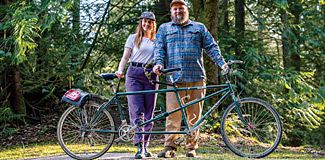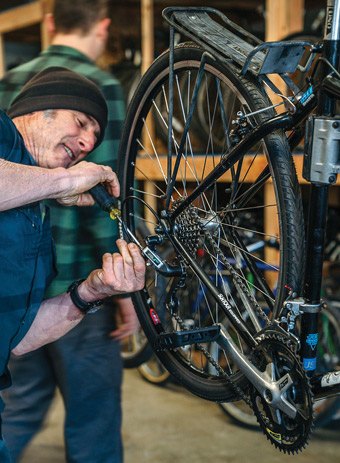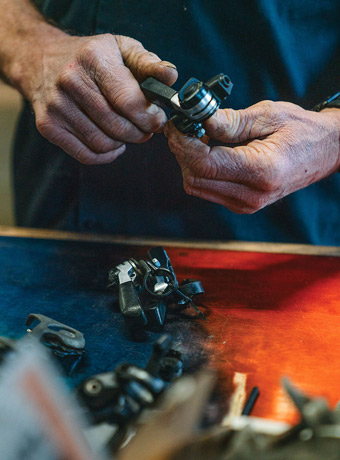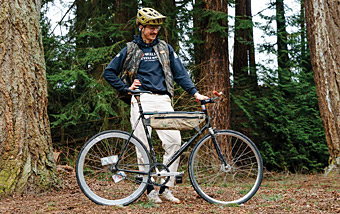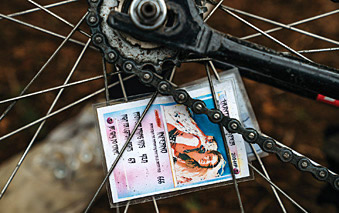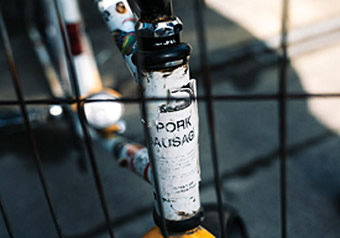| |
|

North Bennett and his Bridgestone Trailblazer mb4
The bicycle I ride most often is my father’s old mountain bike: a Bridestone Trailblazer mb4. He bought it new some thirty-odd years ago and has let me ride it for the past ten. It’s a steel bike, rusty in places but still with solid bones, and admired by cycling buffs around town for its place in mountain bike history. Last spring, I took it to The Hub Community Bike Shop in Bellingham, Washington, for a tune-up and some modest upgrades. The mechanic wore a big grin when he rolled it out a few days later.
“I had a lot of fun banging out some dents in the rim,” he told me. “It’ll work for now, but if you want this to be a forever bike, you’ll probably want to replace that wheel eventually.”
Forever bike. What did that mean? The idea had never before occurred to me. I’d brought my bicycle into the shop, hoping it would make it through the summer, and here I was, faced with the prospect that I might be stuck with it forever. My Bridgestone could be as sturdy as its name: the flow of time could pass right under it, and still, it would persist. Maybe, I thought, it could outlast me.

Kyle Morris is the creator and organizer of The Hub Community Bike Shop,
a nonprofit shop that repurposes bike parts that would typically end up in a landfill.
Building and refurbishing community-donated parts,
The Hub
has been in the business of forever bikes since 2002.
| |
Kyle Morris, The Hub founder, at work |
|
I couldn’t shake the vision of a forever bike. The more I considered it, the more it seemed inevitable, or even ideal. Every bicycle is built of a collection of ancient, venerable forms: two circles and two triangles. In the West, we associate the first shape with perfection and the second with strength. I kept imagining a forever bike glinting into sunset after sunset. I saw it roll on and on —well, duh— forever.
But that is not the bicycle most people know, nor is it the way cyclists often talk about their bikes. More familiar is the ride that is bought and replaced: the economic bicycle. This is the bicycle that partakes in market statistics. According to one forecast, the global bicycle industry is expected to grow by about $45 billion between 2021 and 2029. That’s a lot of credit card swipes.
I love riding bikes, but I am ambivalent about buying things, and cycling is an industry as much as it is a culture. Talking about gear is like talking about the weather: normalized, boring, indispensable. Among my friends, we do it every ride. It seems as if each of our bikes will be perfect after a change or two, or after we have replaced them completely. I am sheepish to admit that I have owned four different mountain bikes in the last two years. I would like to attribute this fact to personal changes in geography, but, in truth, the next bike has always seemed a little bit better. Perversely, my search has led me in a circle: my current mountain bike is nearly identical to the one I started with. I’ve just wasted a lot of time and money in the process.
When I began researching the forever bike, I discovered that its definition changed depending on whom you asked. For some, the term invokes a dream bike, one that a rider has splurged on or perhaps customized from the frame up. For others, it conjures a quiver-killer, that elusive bike that handles anything and everything. For a final subset, the forever bike calls forth a sentimental keepsake whose welds hold some story important to its owner. When I read of these bikes, I thought the first sounded expensive, the second unattainable, and the third like something I would fret over breaking. The forever bike I wanted was more like my favorite ceramic mug: sturdy and utilitarian, a beautiful tool that upheld the pleasures of my everyday life.
In an age when manufacturers design, release, and market new bikes every year, I wanted to know how bicycle companies factored longevity into their design process. I called up Mike Lavery, a Bozeman, Montana-based engineer who has been designing big-name bikes for over a decade. What he told me came as a surprise. Every bicycle sold, he said, must pass a particular set of tests designed by the International Organization for Standardization. These tests model the stresses that a bicycle withstands throughout its regular riding life, and it is not difficult to design one that passes them. What is difficult is designing a lightweight yet stiff bike that still meets these standards. As a result, the cycling industry invests many of its engineering dollars toward understanding what parts of a bike need reinforcement and what can be stripped away. When applied to something like a carbon road bike, this process often yields a frame that will perform reliably under normal riding conditions and then snap when it tips off the back of your car. For a bike that can better withstand the happenstances of regular use, Mike implied, you might as well buy lower down on the product line. There, the excess material that would burden the world’s fastest riders could instead protect your bike from its premature demise.
| |
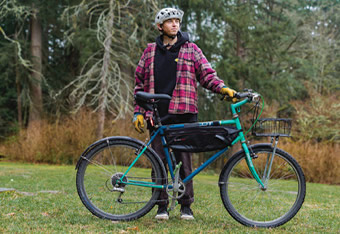 |
|
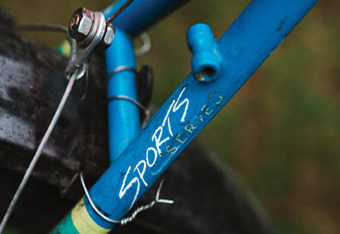 |
|
| |
|
|
|
|
I asked Lavery what he would do if tasked with designing a forever bike. “I’d probably keep the design very simple,” he said. “There is no need to reinvent the wheel.” Lavery told me that proprietary designs, which are often driven as much by marketing concerns as functional ones, are riskier than the tried-and-true methods of bike building that have proven themselves over time. Moreover, they’re harder to construct. “Really complicated designs are the ones that are the most difficult to manufacture. And the bikes that are most difficult to manufacture usually have the most manufacturing defects,” he said. Lavery’s forever bike would be classic and not overly lightweight. The more he described it, the more it seemed like he was describing the bicycle I already owned: my Bridgestone.
My Bridgestone may be special, but that does not make it uniquely qualified to become a forever bike. In truth, it shares a basic geometry with most rigid bicycles built in the last hundred and fifty years, and like them, its frame is made of steel. Steel is known for being relatively lightweight, durable, and repairable: you can weld it back together. In motion, it offers an elastic, lively ride quality that seems both possessed of itself and uniquely attuned to you. Many bike companies still produce steel frames today, but used ones also abound. They have, after all, been mass-produced for over a century and are challenging to break.
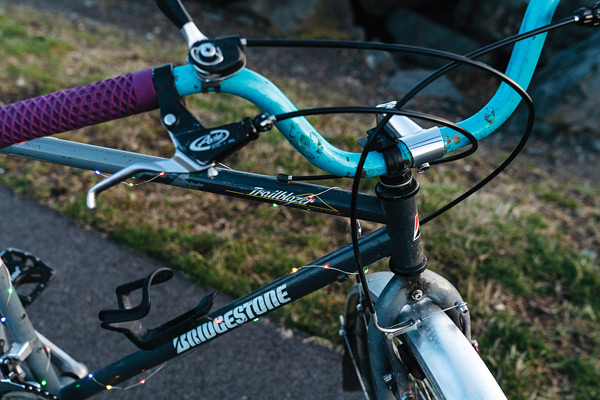
It may not be the latest and greatest in bicycle technology, but North Bennett’s
Bridgestone Trailblazer MB-4 is his idea of a forever bike—
sturdy and steel, he hopes this bike will last a lifetime.
| |
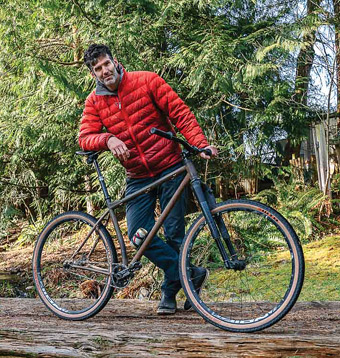 |
|
 |
|
| |
Chris Mandell says his forever bike “Came down to earth on the back of a meteor which originated from the comet Tempel-Tuttle!” While he might be stretching the truth, the raw steel frame and custom build have truly served him well over the years. |
|
Teya Mischaikov acquired hers through a friend. While it may not have been the original owner’s forever bike, one ride on the army green Kona was all it took for Mischaikov to know she’d found the one.
|
|
| |
|
|
|
|
| |
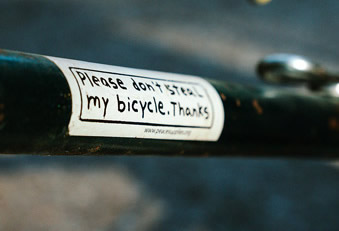 |
|
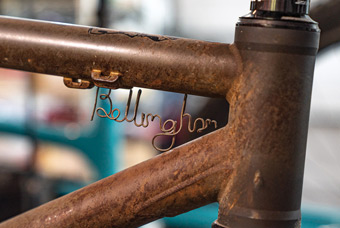 |
|
Forever bikes come in all shapes and sizes. Some are adorned with stickers, LED lights, or celebrity-themed trading cards, but one thing that they all have in common is that they feel like a perfect fit for their rider.
But what of the rest of the bike—all of the components that give you a place to rest your body and a way to power your wheels? Although I dreamt of a bicycle rolling through space forever, I had to recognize that bikes do not live on some ideal, geometric plane, but in a bumpy, gritty world, one beset by the actualities of wear and tear. Tires puncture and deflate. Bolts rattle loose and disappear in ditches. Eventually, even steel or titanium parts wear out. This is the reality of a machine that works by trading energy and friction for spin and glide. In a mechanical world, nothing lasts forever.
Some critics of the forever bike predict that, one day, due to shifting component compatibility standards, the broken parts on an aging bicycle will no longer be replaceable. Its demise will come not from impact, but obsolescence. This seemed like a legitimate concern to me, so I rode my Bridgestone back down to The Hub to see if I should be worried. My steel frame might constitute my bike’s spiritual center, but it would eventually be useless without ready access to replacement components.
When I arrived, I found Kyle Morris, The Hub’s creator and organizer, standing on a stepladder with his face in a box of bike parts. He told me that I didn’t need to fret. Not only can one still buy new components for a 26” bike, but places like The Hub organize and store the very bits that my bike will eventually require. In fact, Morris told me that he prioritizes stocking components for older bicycles like mine.

Sometimes a forever bike is fit for two! Maggie Kaiserman’s husband, Tim Asp,
found their forever tandem on Craigslist and presented it to Maggie as a birthday gift.
Three years later, the couple is cruising around town on their Santana with no plans to stop.
“Bike parts change so fast—there are so many options—that we don’t have enough space to keep everything congruent with the variety that’s out there,” he said. “[But] for twenty-five or thirty years, things remained relatively unchanged, and you could count on them,” he said, referring to the last decades of the twentieth century. Morris told me that he often throws newer parts away because he can’t find enough eligible bikes for them. “In my opinion, the old stuff is what will keep going for eternity, and the new stuff is here today, gone tomorrow,” he said.
Morris looped another person in the shop into our conversation. His name was Adam, and he had a forever bike. It was sitting right there: a sleek black steel bicycle. I asked Adam how he knew that this was the bike for him.
“It fits just right,” Adam said, sighing as if he were easing back into a La-Z-Boy.
“When you find that bike that fits you, you never want to let it go,” Morris added.
As I wheeled myself out of The Hub, I thought about how I had always based my search for the right bicycle on future hypotheticals: what a bike could do or where it could take me. I had never considered the attachments that tied me to the ride I already had. Those attachments included family and history and memory, but, more basically, they included the brute force of gravity. Here I was, feet on the pedals and butt on the seat, and my Bridgestone felt good. Never mind its bulging tires or brake-worn rims, the thing kept rolling and I kept riding. As far as I could tell, we were on forever.
About the Author
| |
North Bennett lives, works, and plays in the northwestern United States. He is a member of the Confluence Lab (an interdisciplinary group of artists, writers, and social scientists), and has published work in Mangoprism, The Climbing Zine, and Craft MTN. North enjoys trail running, good jokes, and activities that go whee! He can be reached at enorthbennett@gmail.com |
|
 |
|
|
|
|
